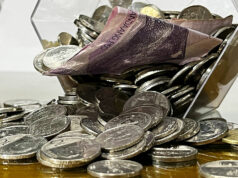Peso slips on slower GDP growth
THE PESO slipped against the dollar on Thursday following data showing slower-than-expected Philippine economic growth in the second quarter and ahead of the central bank’s move to raise interest rates anew.
The local unit ended Thursday’s session at P53.09 versus the greenback, two centavos weaker than the P53.07-per-dollar finish on Wednesday.
The peso opened Thursday’s session slightly stronger at P53.055 against the dollar. It logged an intraday low of P53.185, while its best showing for the day stood at P53.05 versus the greenback.
Dollars traded slid to $682.1 million from the $721.15 million that exchanged hands the previous day.
A foreign exchange trader said the peso traded “wildly” following the release of the second-quarter gross domestic product (GDP) growth data.
“Although Thursday’s close was near the previous close, the dollar-peso traded wildly intraday after the GDP growth figure missed market expectations,” the trader said in a phone interview.
The Philippine economy grew 6% in the second quarter, slower than the downward-revised 6.6% GDP growth in the first quarter as well as the 6.7% pace logged in the same period last year. This was also slower than the 6.8% median estimate in a BusinessWorld poll conducted last week.
This brought the first-half print to 6.3%, below the government’s 7-8% target band for 2018.
Socioeconomic Planning Secretary Ernesto M. Pernia partly attributed the slower GDP growth to the “prudent and judicious policy decisions to promote sustainable development” such as the closure of the Boracay island as well as regulation of mining activities.
“The slower-than-expected [second-quarter] GDP print has rendered the peso weaker as the actual totally missed market and government forecasts,” UnionBank of the Philippines chief economist Ruben Carlo O. Asuncion said in a text message.
The trader added that the peso-dollar pair might consolidate on Friday following the decision of the Bangko Sentral ng Pilipinas (BSP) to tighten policy rates anew.
At the market’s close, the central bank announced that it decided to raise its interest rates by 50 basis points (bp) at Thursday’s review to temper inflation expectations, stronger than the 25-bp hikes announced in May and June.
“Upside risks also continue to dominate the inflation outlook, as the sustained increase in core inflation suggests broadening price pressures amid resilient aggregate demand conditions,” the BSP’s Monetary Board said.
BSP’s benchmark rates now stand within a 3.5-4.5% range.
“The movement of the peso might be tricky [on Friday] because some players might react to the 50-basis-point hike, although it was factored in already the past few trading sessions,” the trader said.
Meanwhile, Mr. Asuncion said the BSP’s policy tightening will be “positive” for the peso.
For Friday, Mr. Asuncion sees the peso moving between P52.80 and P53 versus the dollar, while the trader gave a P53-P53.20 range. — Karl Angelo N. Vidal



